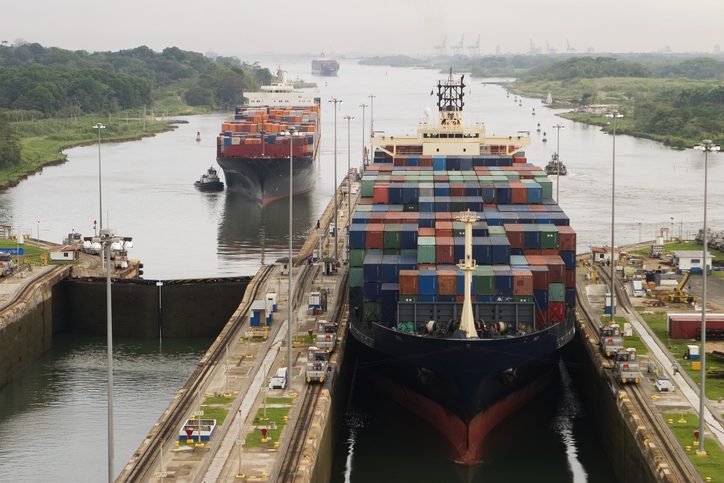Canals become bottlenecks for global shipping again

Authored by HDI
As shipping attacks continue to restrict access to the Suez Canal, drought is reducing traffic through the Panama Canal. Logistics networks have shown resilience so far, but if the issues persist, longer-term effects could be more serious.
After a decade of declining piracy rates, the safety of crew and cargo onboard the world’s biggest transport vessels has become a top priority for governments and businesses in recent weeks. Houthi rebels based in Yemen have launched a series of attacks on commercial ships passing through the Bab-el-Mandeb strait to the Red Sea. Many firms are now avoiding the route, imposing delays on global supply chains and increasing container freight rates.
The Red Sea is one of the most important arteries in the world’s logistics network. Ships usually pass through it to reach the Suez Canal, which is the quickest naval route between Asia and Europe. Around 17,000 ships navigate the Suez Canal each year, carrying USD 1 trillion worth of goods and 12 per cent of annual global trade.
Supply chain delays hit numerous sectors
In response to the attacks, which the Houthi hope will force Israel to end its military campaign in Gaza, many shipping firms are now avoiding the area. The alternative route is several thousand miles longer, around South Africa’s Cape of Good Hope – adding 10 to 14 days of journey time and roughly USD 1 million in fuel costs.
This is already affecting tightly planned global shipping schedules. Asia-Europe freight rates have risen by more than 250 per cent since December (but are still well below the highs during Covid) and numerous industries are now reporting supply chain delays.
In the automotive sector, which favours ‘just-in-time’ manufacturing processes without large stockpiles, Tesla, Volvo and Suzuki have all announced cutbacks in European production due to component shortages. Some companies in Germany’s chemical sector, the largest in Europe, have also reported disruption to production. Furniture giant Ikea has said shipping delays could hit product availability.
More serious than ‘traditional’ piracy
The last time shipping firms faced serious security threats was during a spate of piracy attacks off the coast of Somalia in the late 2000s and early 2010s. This trend was eventually curbed by a combination of international peacekeeping efforts and private armed guards onboard some vessels.
But this is different. Attacks in the Indian Ocean were typically carried out by small groups in fishing boats with limited arms. The Houthis are using drones, missiles and fast boats – a far more serious combination that only government intervention can stop. Air strikes and naval escorts have done little to deter the attacks so far.
Additional disruptions in Panama
While disruptions in the Red Sea have grabbed the majority of headlines in recent weeks, another challenge is now emerging for global shipping. Severe drought in some parts of Central America has forced the Panama Canal Authority to reduce the number of daily transits by a third.
Approximately 2.5 per cent of global maritime trade – totalling USD 270 billion worth of cargo – sails through the canal each year, which is particularly important for bringing goods to and from the Americas. The situation remains in flux, but if restrictions persist, this could be a further disruption to the closely connected network of global shipping.
According to a recent analysis by McKinsey, the restrictions will likely result in “across-the-board cost increases, regardless of how affected parties react”.
The combination of events in Panama and the Red Sea is a serious test for the resilience of global shipping. Consumers are yet to feel the effects of delays and increased transportation costs, but this may be inevitable if problems continue.






